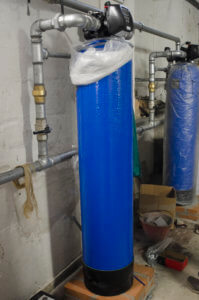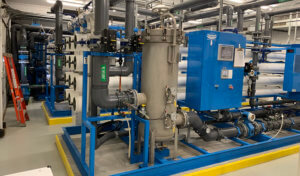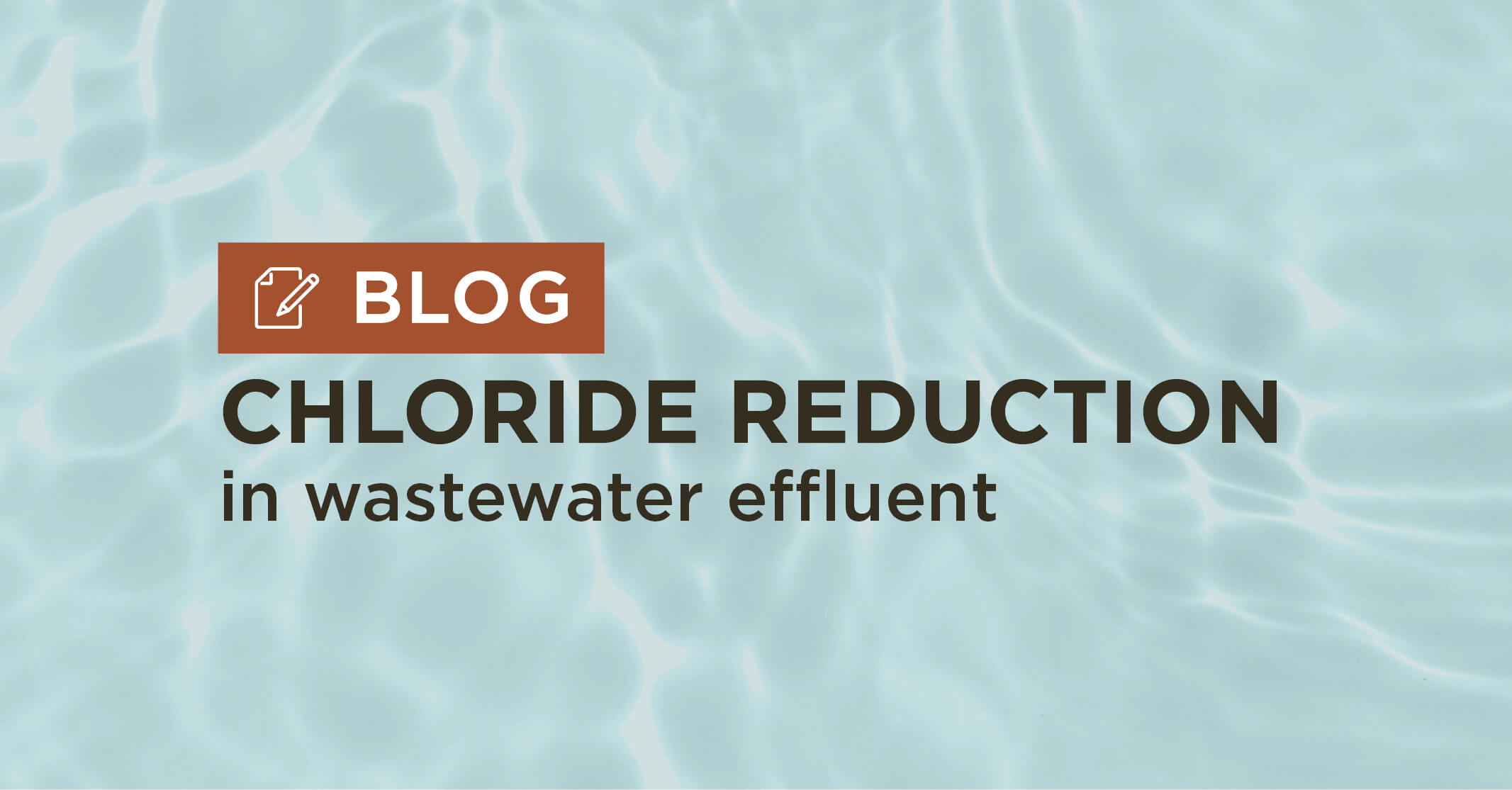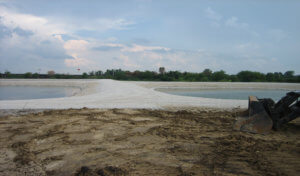Hard Water Problems Create Demand for In-Home Softeners

Water softeners come in many sizes. This industrial-sized softener can be used during centralized softening.
When homeowners experience a chalky deposit buildup on showerheads, faucets, or drinking glasses, the likely culprit is hard water. This aptly named annoyance is simply water with a high concentration of dissolved minerals, mainly calcium and magnesium. While drinking hard water may help you get your recommended daily intake of these essential minerals, hard water can cause corrosion in plumbing and appliances over time.
To head off potentially expensive repairs, many homeowners turn to residential water softeners that remove these pipe-damaging minerals through ion exchange. However, the byproducts of this relatively inexpensive solution, mainly sodium chloride, seriously impact surrounding water ecosystems and municipal wastewater treatment plants.
How Chloride Loading Affects Municipal Wastewater Systems
While salt used to de-ice roadways in northern climates also contributes to environmental damage, it is the water-softening process that creates the most harm nationwide, and in many municipal wastewater systems, water softener discharges are the most significant contributor to elevated chloride levels. Water softeners are designed to reduce dissolved minerals by exchanging the ions in hard water with the ions of another substance. The ions are typically exchanged with ions from a dissolved sodium chloride salt or brine.
As these systems create soft water, the excess ions and leftover salt create a highly concentrated backwash concoction which then gets sent to municipal wastewater treatment facilities. Because many facilities aren’t equipped to remove this solution, high amounts of chloride eventually pass through, ending up in lakes, rivers, and streams. Over time, accumulated chloride levels have proven toxic to fish, other aquatic creatures, and plants.
Regulatory Requirements & Chloride Variance
This excess release of chlorides into the environment is particularly a problem in regions of the country where local geology contributes to naturally hard water. In these areas, many residential, commercial, and industrial facilities continually utilize a softener. This leads to municipal treatment facilities facing increasing requirements to reduce chloride loading and follow wastewater discharge regulations.
As with most permitting limits, these requirements primarily come from the federally mandated Clean Water Act (CWA) of 1972 and several major revisions made five years after implementation. These amendments require the Environmental Protection Agency (EPA) to regularly publish updated Water Quality Criteria (WQC) that reflect the latest scientific data on pollutants and their effects on area waters and aquatic environments. Following this requirement, the EPA published Water Quality Standards (WQS), identifying how people, aquatic communities, and wildlife use the local waters. By defining these uses, enforceable effluent limitations are set and implemented through National Pollutant Discharge Elimination System (NPDES) permit programs.
Most NPDES permit holders are familiar with effluent chloride limits. However, in recent years, discussions about compliance have seemingly increased. Much of this is due to changing requirements that evolved with the EPA offering a chloride variance.
In 2015, the EPA established a Highest Attainable Condition (HAC) criterion for variances in effluent wastewater limits. According to the EPA, these time-limited quality standards strike a balance between providing states and dischargers the time and flexibility to make incremental water quality improvements. These improvements should reflect the best quality achieved in each period, with built-in accountability measures to assure the public that progress will occur. As part of the variance process, it’s also necessary that permit holders identify, implement, document, and report all source reduction efforts during the term of the permit.
As society continues to evolve policies and responsiveness towards environmental conservation, many communities look toward viable solutions to further reduce chloride in their effluent. A potential solution to this issue is shifting from home-based water softening to a centralized softening system where water is treated at drinking water facilities before reaching the end customers.
Implementing Centralized Softening to Reduce Chlorides
Centralized softening is a path that many municipalities take to provide softened water to households, commercial and industrial users, allowing individual customers to reduce or remove their in-home equipment. While there are several options, the two most common are a lime softening or reverse osmosis (RO) filtration system.
Lime Softening
In the lime softening process, the pH of the water being treated is raised to shift the equilibrium of carbonate types in the water. The normal pH of water is between 6.5 and 8.5 but during lime softening treatment. Plants typically operate in the pH range of 10.5. Calcium carbonate solubility decreases as pH increases, causing a precipitation reaction to reduce hardness.
During this single-ingredient reaction, the process produces residual lime sludge. This presents a potential downfall for the treatment as the total amount of dry-weight solids produced is approximately twice the amount of hardness removed using the straight lime process.
Reverse Osmosis

Our team installed a RO system in Oakland that produces about 325 gallons of permeate water per minute. Once treated, the water leaves without hardness, radium, or contaminants.
Reverse osmosis (RO) is another treatment process that can centrally soften drinking water before distribution to customers. The RO method softens water through a filtration and removal process where it is subjected to high pressures, pushing it through an extremely fine porous membrane. Pollutants are filtered and flushed away during this process, producing soft, clean water.
However, RO systems come with disadvantages, as well. The primary issue is the amount of water wasted by the process. For each gallon of water produced, between 10 and 20 percent is lost as waste. Along with significant capital and operating costs associated with RO, the system membrane efficiency declines over time, requiring periodic replacement. As declination occurs, more energy is needed for adequate treatment. The presence of hard water and metals only shortens the life span of these membranes.
Centralized Systems Improve, But Don’t Perfect Waste Issues
If a centralized softening system is developed, some residents will still run in-home water softeners. While not ideal, the concentration of chloride that the wastewater system would receive would be significantly lower, with the water being “pre-softened” through one of the two previously listed technologies before reaching residents.
These systems can reduce the amount of chloride a community sees returning to wastewater facilities compared to the amount discharged through multiple household-level softeners. Concurrently, consumer costs associated on a per-gallon basis are reduced due to the higher efficiency of the process, the utilization of singular equipment for an entire community, and the elimination of individualized system maintenance expenses.
Offering Community Incentives & Monitoring
While some communities are taking the above-described central softening route, others offer grants or incentives to residents to switch to more efficient water softeners. High-efficiency water softeners are specially engineered to provide as many gallons as possible of soft water while using the lowest amount of salt possible. These newer appliances typically use half the amount of salt and water per regeneration than standard on-demand water softeners.
Additional efforts include placing monitors like those that measure water consumption in homes with water-softening systems. These systems are set to track chloride levels discharging from individual residences. The chloride levels are checked regularly, and if the monitor reveals that the effluent exceeds local mandates, fines may occur.
When pursuing these efforts, a key challenge is educating the public on the balance between necessity and preference with water softening practices. At Snyder & Associates, public evolvement provides the foundation for project success. Because of this, we offer various engagement services to help educate and unify your community. By reducing significant amounts of chlorides released into our water systems, we are diminishing our contribution to the higher overall salinity and the need for softening before the cycle starts again.

